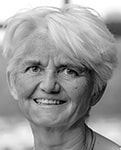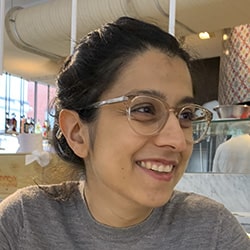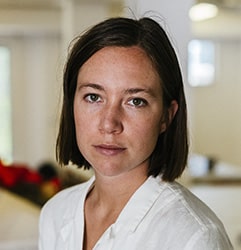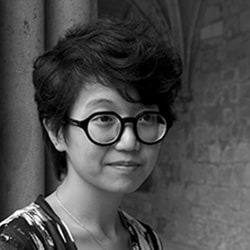CMU's Center for the Arts in Society Launches Borderlines Initiative
By Stefanie Johndrow
Media Inquiries- Dietrich College of Humanities and Social Sciences
- 412-268-1788
CAS plans to approach the Borderlines Initiative with the idea that "borders are embedded in human experience, from the international to the cells in our bodies." The initiative aims at highlighting the artistic, theoretical and social issues that occur when considering the concept of borders in aesthetics, politics, technology and the everyday.
 "It is exciting for CAS to begin a new initiative. Every three years we rethink our exploration of research between the arts and humanities by choosing a new theme. 'Borderlines' articulates so much about our present situation. Each of the selected projects explores the theme in a unique way, yet they are in conversation with each other," said James Duesing, CAS director. "We are launching the initiative this fall, and I think there will be some part of the programing that will interest everyone in the university."
"It is exciting for CAS to begin a new initiative. Every three years we rethink our exploration of research between the arts and humanities by choosing a new theme. 'Borderlines' articulates so much about our present situation. Each of the selected projects explores the theme in a unique way, yet they are in conversation with each other," said James Duesing, CAS director. "We are launching the initiative this fall, and I think there will be some part of the programing that will interest everyone in the university." Leading the borderlines initiative are Mary-Lou Arscott, studio professor and associate head of the School of Architecture, and Nico Slate, professor of history and head of the Department of History. They will oversee three faculty-led projects that find new ways to address borders while advancing artistic and humanistic creativity, knowledge and research.
Leading the borderlines initiative are Mary-Lou Arscott, studio professor and associate head of the School of Architecture, and Nico Slate, professor of history and head of the Department of History. They will oversee three faculty-led projects that find new ways to address borders while advancing artistic and humanistic creativity, knowledge and research. "Ours is a world of many borders. As the COVID-19 pandemic makes clear, borders are places of contact and crossing, as well as markers of division and inequality. This is a time when we need to interrogate the many borders of our lives," Slate said. "I am delighted to be helping coordinate this new initiative with Mary-Lou Arscott, and to be working with such a remarkable group of scholars whose work crosses borders of many kinds."
"Ours is a world of many borders. As the COVID-19 pandemic makes clear, borders are places of contact and crossing, as well as markers of division and inequality. This is a time when we need to interrogate the many borders of our lives," Slate said. "I am delighted to be helping coordinate this new initiative with Mary-Lou Arscott, and to be working with such a remarkable group of scholars whose work crosses borders of many kinds."According to Arscott, an excerpt from Judith Butler's "Frames of War: When Is Life Grievable?" is emblematic of their approach as coordinators: "our very survival depends not on the policing of a boundary [...] but on recognizing how we are bound up with others, then this leads us to reconsider the way in which we conceptualize the body in the field of politics."
"Our questions are urgent at this moment and all of the contributors to the Borderlines Initiative will expand our thinking and our ability to formulate new conceptual structures," Arscott said.
Borderlines Initiative Projects
Spaces of Containment and Care
Nida Rehman, Lucian and Rita Caste Assistant Professor, School of Architecture The circulation of viruses and other pathogenic agents is variously shaped by, and calls into action, the form and organization of the built environment. The inequities and injustices of urban space and infrastructure, created by long (and ongoing) histories of segregative and extractive development, configure vastly differentiated experiences of vulnerability. At the same time, the demarcation of hygienic, social and territorial borders to control disease has often relied on social and racial constructions of purity and filth and on a racialized calculus of "valued and disposable lives." In the context of the ongoing COVID-19 pandemic, concepts like quarantine, confinement, shutdown, surveillance, social distance, isolation, shelter-in-place, stay-at-home, lockdown and red zones index a heterogeneous and differentially executed set of spatial responses to disease transmission in global health frameworks. These forms of biopower, as the history urban epidemiological control shows, become inscribed in built form, reinforcing structural hierarchies of race and class.
The circulation of viruses and other pathogenic agents is variously shaped by, and calls into action, the form and organization of the built environment. The inequities and injustices of urban space and infrastructure, created by long (and ongoing) histories of segregative and extractive development, configure vastly differentiated experiences of vulnerability. At the same time, the demarcation of hygienic, social and territorial borders to control disease has often relied on social and racial constructions of purity and filth and on a racialized calculus of "valued and disposable lives." In the context of the ongoing COVID-19 pandemic, concepts like quarantine, confinement, shutdown, surveillance, social distance, isolation, shelter-in-place, stay-at-home, lockdown and red zones index a heterogeneous and differentially executed set of spatial responses to disease transmission in global health frameworks. These forms of biopower, as the history urban epidemiological control shows, become inscribed in built form, reinforcing structural hierarchies of race and class.
Bird Project
Isla Hansen, assistant professor, School of Art "Bird Project" focuses on birds as charismatic vessels for thinking across borders. Birds are natural transgressors, migrating across natural and manmade borders, navigating both urban human environments and dense forests. Birds exist throughout the world as pets, as captives, as sustenance, as tools, as mascots, as wildlife, as inspiration, as symbols of both wealth and poverty. Birds have formed relationships with humans across geographic borders and across socioeconomic, racial, ethnic and cultural spectrums all over the world. They are social, cooperative, musical, and as the only living dinosaurs, birds connect us across time to an earth without humans.
"Bird Project" focuses on birds as charismatic vessels for thinking across borders. Birds are natural transgressors, migrating across natural and manmade borders, navigating both urban human environments and dense forests. Birds exist throughout the world as pets, as captives, as sustenance, as tools, as mascots, as wildlife, as inspiration, as symbols of both wealth and poverty. Birds have formed relationships with humans across geographic borders and across socioeconomic, racial, ethnic and cultural spectrums all over the world. They are social, cooperative, musical, and as the only living dinosaurs, birds connect us across time to an earth without humans.
Body Doubles
Annie Hui-Hsin Hsieh, assistant teaching professor, School of Music
Whitney Laemmli, assistant professor, Department of History

 "Body Doubles" is an interdisciplinary project that seeks to explore the porous boundaries between our biological selves and our digital "data-doubles" in the twentieth and twenty-first centuries. Though states, scientists, artists and engineers have long observed and gathered information about the human body, in recent years, such data is being collected in far greater volumes and utilized and represented in new ways. Facial recognition and biometric systems transform human physiognomy into strings of 0s and 1s, wearable fitness trackers create digital portraits of motion and stillness, robots perform Japanese folk dances, and humanoid avatars populate video games, concert performances and virtual conference rooms.
"Body Doubles" is an interdisciplinary project that seeks to explore the porous boundaries between our biological selves and our digital "data-doubles" in the twentieth and twenty-first centuries. Though states, scientists, artists and engineers have long observed and gathered information about the human body, in recent years, such data is being collected in far greater volumes and utilized and represented in new ways. Facial recognition and biometric systems transform human physiognomy into strings of 0s and 1s, wearable fitness trackers create digital portraits of motion and stillness, robots perform Japanese folk dances, and humanoid avatars populate video games, concert performances and virtual conference rooms.